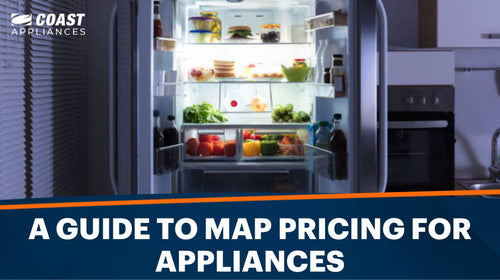A freezer is one of the most valuable appliances in your kitchen. It can help you store food when it's on sale, save leftovers, and even prepare meals in advance. But with all the different types of food going in and out, what is the right temperature for a freezer? Also, how can you tell if your freezer is set to the correct temperature? This article will explore the ideal freezer temperature range, how to properly calibrate your freezer, and the potential dangers of having a freezer set too warm or too cold. Read on to find out:
- What is the normal freezer temperature?
- FAQs about freezer temperature
What Is the Normal Freezer Temperature?
According to the United States Department of Agriculture (USDA), the ideal freezer temperature is 0 °F (-18 °C) for all food storage. This ultra-low temperature creates a deep freeze, inactivating any type of bacteria, yeast, and mold that may be present in the food. Consequently, these disease-causing microorganisms will not grow and multiply, keeping the food safe to eat for longer periods of time.
Though declared optimal, the 0 °F (-18 °C) setting may seem extreme for some foods. After all, it's a fact that different foods freeze at different temperatures. However, that doesn't mean these temperatures are the best to store food. Not if you want it to be fresher for longer. Setting your freezer to the recommended temperature will accommodate different types of food storage, from meats to vegetables to desserts.
Keeping food at the recommended temperature keeps it out of the danger zone, the range in which bacteria in food can grow. This temperature range is 49 °F and 140 °F (4 °C and 60 °C), and food kept in this range for more than four hours should be thrown away to prevent food poisoning and other illnesses.
It is also worth mentioning that keeping your freezer at the correct temperature is not only crucial for food safety. Doing so can also help save energy and prolong the life of your freezer. A freezer that runs too warm will have to work harder to maintain the desired temperature, leading to increased energy consumption and wear and tear on the machine.
Note: While freezing does not kill most bacteria, it does stop bacteria from growing. Though food will be safe indefinitely at 0 °F, quality will decrease the longer the food is in the freezer.
So, how do you ensure you set the temperature correctly? Check the settings on your freezer's control panel. Additionally, ensure you have a reliable freezer thermometer to confirm the readings are accurate. Place the thermometer in a glass of water, put it in the middle of the freezer, away from the walls and door, and leave it for at least 5 minutes. This will give you an accurate reading of the temperature inside the freezer. Adjust the thermostat accordingly if the temperature is not within the safe range.
There are a few ways to determine if your freezer temperature is set correctly:
- Check your ice cream: If your ice cream is hard and has a smooth consistency, your freezer is likely set at the correct temperature. It may be set too warm if it's soft or has ice crystals.
- Check your frozen vegetables: If the vegetables are crispy and don't have any signs of freezer burn, your freezer is likely set at the correct temperature. If the vegetables are limp or have ice crystals, it may be set too warm.
- Check the temperature display: Some freezers have a built-in temperature display that shows the current temperature inside the freezer. Compare this reading to the recommended temperature range to see if your freezer is set correctly.
Keep in mind that it's not just about the temperature. The freezer door seal should also be tight and in good condition, so the cold air doesn't escape.
FAQs About Freezer Temperature
What temp is too high for the freezer?
Any temperature above -18 degrees Celsius (0 degrees Fahrenheit) is considered too high for a freezer. At temperatures above this, bacteria and other microorganisms can begin to grow and multiply, potentially leading to food spoilage and foodborne illnesses. Additionally, food stored at high temperatures may not freeze properly and can become partially thawed and refrozen, which can negatively affect its quality and texture. Keep your freezer temperature at or below the recommended range of -18 degrees Celsius (0 degrees Fahrenheit) to ensure safe and proper food storage.
What is the lowest temperature of freezers?
The lowest temperature a freezer can achieve is typically around -23 degrees Celsius (-9 degrees Fahrenheit), depending on the model and make of the freezer. This temperature is considered the coldest setting a freezer can reach, and it is ideal for storing food that needs to be kept at extremely low temperatures. However, it's important to note that even at the lowest temperature, bacteria and other microorganisms can still survive, so it's essential to properly package and store food in the freezer to prevent contamination and cross-contamination.
What happens if a freezer is too cold?
If a freezer is set too cold, it can adversely affect the food stored inside. Some of the potential issues that can occur include:
- Freezer burn: When food is stored at temperatures below -18 degrees Celsius (0 degrees Fahrenheit), the moisture inside the food can evaporate and form ice crystals on the surface of the food. This process is known as freezer burn and can cause the food to become dry, discolored, and unappetizing.
- Quality loss: Extremely cold temperatures can cause some foods to lose their texture, flavor, and nutritional value over time. For example, some fruits and vegetables may become mushy or lose their color when stored at temperatures below -12 degrees Celsius (10.4 degrees Fahrenheit).
- Increased energy consumption: Keeping a freezer at an unnecessarily low temperature can increase energy consumption, leading to higher electricity bills.
- Frost buildup: An excessively cold freezer can cause frost to build up on the walls and interior of the freezer, reducing the appliance's efficiency.
Is 5 degrees OK for the freezer?
Yes, 5 degrees Fahrenheit (-15 degrees Celsius) can be an appropriate temperature for a freezer. According to the United States Department of Agriculture (USDA), the ideal temperature for a freezer is 0 degrees Fahrenheit (-18 degrees Celsius) or below. This ensures any bacteria present in the food will not grow and multiply, keeping the food safe to eat for longer periods of time. However, most freezer manufacturers recommend keeping the appliance between 0 and 5 degrees Fahrenheit for optimal performance.
Is 7 degrees cold enough for a freezer?
No, 7 degrees Fahrenheit (-13 degrees Celsius) is not cold enough for a freezer. Anything above the USDA-recommended 0 degrees Fahrenheit (-18 degrees Celsius) is not ideal. At 7 degrees Fahrenheit, the food inside the freezer will not be at a safe temperature for storage and may be at risk for bacterial growth, spoilage, and foodborne illness. The bacteria, yeast, and mold present in the food may start growing and multiplying at this temperature, making the food unsafe to consume.
Is frozen food safe at 25 degrees?
No, food stored at 25 degrees Fahrenheit (-4 degrees Celsius) is not safe. When it comes to freezing, the ideal temperature is as close to 0 degrees Fahrenheit (or -18 degrees Celsius) as possible. While low temperatures may not kill all disease-causing microorganisms, they do stop the growth, keeping the food safe to consume.
However, if the freezer temperature rises above 0 degrees Fahrenheit, the food starts to thaw, and the microorganisms start to multiply. That's why it's essential to keep a close eye on your freezer's temperature and ensure it's set to the proper range. So, if your freezer's temperature is at 25 degrees Fahrenheit (-4 degrees Celsius), unfortunately, the food stored inside is not safe to consume anymore. It has already entered the danger zone and should be tossed out.
Will meat freeze at 20 degrees?
Meat will not freeze at 20 degrees Fahrenheit (-7 degrees Celsius). The freezing point of water is 0 degrees Celsius (32 degrees Fahrenheit), and the freezing point of most meats, including beef, pork, and chicken, is slightly lower than that. The ideal temperature for freezing meat is between -18 and -23 degrees Celsius (0 to -9 degrees Fahrenheit), as recommended by the United States Department of Agriculture (USDA) for safe and optimal storage. At 20 degrees Fahrenheit, the meat will not be at a safe temperature for storage.
Conclusion
Maintaining the correct freezer temperature is crucial for food safety, energy efficiency, and the longevity of your freezer. Remember to check your freezer regularly to ensure it achieves the recommended 0 degrees Fahrenheit (-18 degree Celsius). Use a thermometer to check the temperature inside the freezer, and adjust the thermostat accordingly.
If you're in the market for a new freezer, be sure to browse our full selection of top-quality, energy-efficient models designed to keep your food frozen at the ideal temperature. With a wide variety of sizes and styles to choose from, you're sure to find the perfect freezer to suit your needs and budget. Whether you're looking for a compact model for your apartment or a large model for your family, we have the perfect freezer for you. Browse our selection today and take the first step toward keeping your frozen food safe and delicious!















